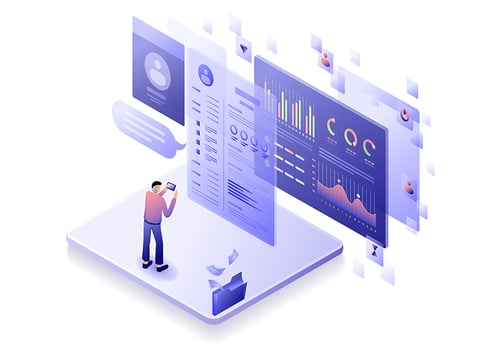A data lake is a foundation for analytics use cases requiring an efficient and scalable collection and processing of large volumes of structured, unstructured, and semistructured data assets. It follows an architectural approach of self-service data consumption agnostic to the process, data formats, and infrastructure environment, allowing organizations to build an automated and scalable data platform.
Data lake technology accelerates the adoption of analytics use cases, including descriptive, diagnostic, predictive, and prescriptive analytics. One of the essential data lake characteristics is its ability to integrate multiple data sources, deliver end-to-end management for enforcing data governance, compliance, and security, and ultimately produce quality analytics use cases for trusted business outcomes.

In this blog, we will review how data lake technologies differentiate from traditional alternatives, such as data warehousing technologies, to solve some of the key challenges facing analytics use cases:
Simplified Data Onboarding
Data is loaded directly from the source, stored untransformed at the leaf level, and no data is turned away. Data Producers – the entities responsible for collecting, processing, and storing data from their respective domains for later consumption – are not required to maintain the entire data-sharing process between all sources. With the traditional data warehousing approach, data is cleansed, structured, and maintained in silos based on the requirements of individual Data Consumers. This makes it challenging for analytics users who require continuous access to real-time data streams from multiple data sources – especially for predictive analytics use cases such as anomaly detection and network monitoring.
Low Data Consumption Overhead
Data lake offers a schema-less approach to onboard large data assets that can be collected and stored in raw formats. Relevant users can process the raw information as required. This reduces the development time for analytics use cases as data lake technologies do not follow a complex ETL logic and processing, which requires heavily normalized models and offers limited flexibility to change. As the data is ingested and stored in raw format – structured, unstructured, and semi-structured – there are no coupling and dependencies introduced during the ingestion process. Instead of developing highly complex models, data can be captured at scale, at a lower cost, and consumed with automated and semi-automated processes. These processes can be standardized and managed independently between data producers and consumers based on varied security, governance, and management control requirements.
Eliminating Data Silos
With the traditional data warehousing approach, where the data undergoes ETL pre-processing and is prepared for specific analytics use cases, data silos are a natural consequence. Stored data may be available or usable for individual and isolated departments or business use cases. Data silos may create the same data with different content, leading to accidental overwriting with outdated information. To address these limitations, additional resources may be required to work around or maintain multiple data repositories based on the requirements of different data consumers. Real-time analytics is challenging when the data is stored in different storage locations and requires additional analysis, such as correlations between data sets to identify and obtain knowledge of the available data. It cannot scale as new data sources are added. Due to the traditional data management policies and lack of automation, users may be required to overcome additional bureaucratic hurdles before accessing data stored across siloed repositories.

Data lake technologies eliminate data silos by maintaining a centralized data repository and automating data processing and management to integrate information generated across multiple sources. With data lake technology, data models do not fragment the information at source collection. Users can determine the data assets they require for their data analytics use case, access data into an intermediate storage location where it can be transformed and managed to meet specific requirements, and then publish the processed information. Instead of transforming all data assets, it is transformed on an as-needed basis. This refers to the principle of schema-on-read, where data is not stored with a predefined schema but processed as it is parsed and adapted into a required schema based on the analytics use cases.
Enhancing Data Usability
A significant challenge for analytics use cases such as predictive and prescriptive analytics is related to the usability of available data. Data may be stored in an unusable format, incomplete, or spread across silos, which renders it ineffective for analytics use cases without spending additional resources on data management and quality overhead. Considering these limitations, users may only explore a limited set of questions and business use cases instead of exploring all possibilities that fully-available data sets may present. To bypass these limitations, many users define their data models, maintain copies of a growing pool of data sets and then use it in siloes. Any measure to merge such a fragmented pool of data assets adversely affects the dataset by adding to the inconsistency, incompleteness, and incorrectness. Despite additional data management measures, data usability still needs to improve for new analytics use cases across different business functions and data consumers.
Data lake technology enhances the usability of information by maintaining a single source of truth – a consistent version of all data assets maintained within a centralized repository and access to all data consumers based on organizational policies. The information maintains its original format and structure and is synchronized in real-time (if required). Data can be discovered using consistent and shared definitions for all attributes and entities applicable.
Data Security, Governance, and Controls
Data lakes allow users to take advantage of real-time streams for analytics use cases. Naturally, this results in the growing volumes of information that may be stored and processed for future analytics use cases. While cloud storage is relatively inexpensive, many costs and resource overhead are associated with managing the growing volumes of data within a secure and compliant storage repository. Data lake makes it easier to democratize data while enforcing security and governance controls in line with organizational policies. These complex processes can be automated, adopting appropriate security and access controls as different user personas and data consumers access sensitive business information for their analytics use cases.

An essential question for IT in this context is to evaluate how their data lake is managed to meet the desired data governance and security standard. It is counterintuitive to eliminate the possibility of creating a data swamp – a data lake with growing volumes of stored data but without the necessary data management and quality controls.
Are you interested in learning more about a data lake solution for cost-effective, secure, and efficient analytics processing on real-time data streams? Let’s talk today to accelerate your digital transformation journey with a data lake solution that solves your organization's unique data analytics challenges.


